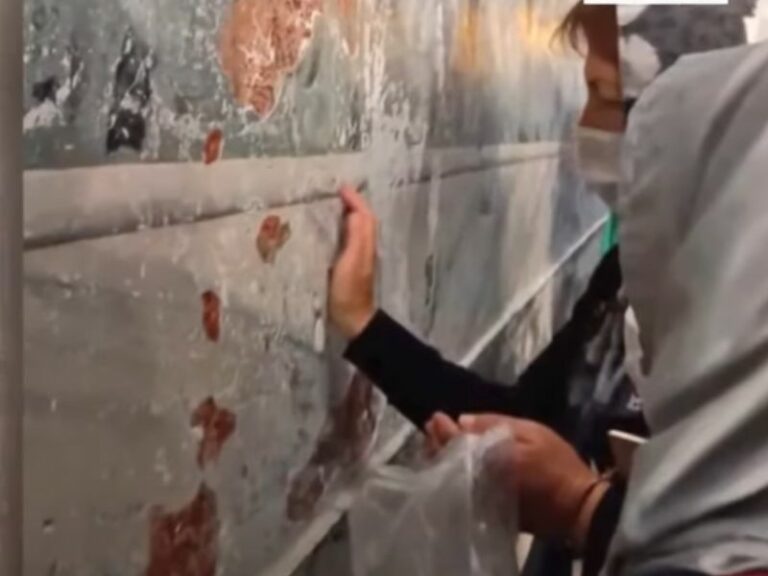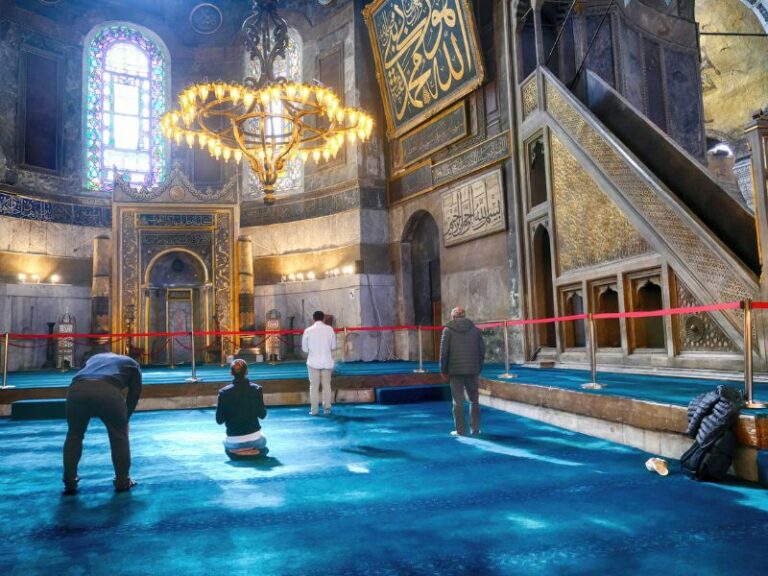Table of Contents
Introduction
Hagia Sophia is not just an architectural wonder—it is also a spiritual gallery, richly adorned with sacred imagery that once defined the religious and political identity of the Byzantine Empire.
Among its most profound visual expressions of faith are the Christ Pantocrator mosaic and the Virgin Mary, whose presence within the monument still resonates with awe and reverence.
Though concealed for centuries during its time as a mosque, these masterpieces were revealed once again in the 20th century, reviving a lost chapter of Byzantine artistic and theological brilliance.
Christ Pantocrator: The Ruler of the Universe

The Meaning and Theology Behind the Christ Pantocrator Mosaic
The Christ Pantocrator mosaic is one of the most emblematic portrayals of Jesus in Eastern Christian art. The term “Pantocrator” translates to “Ruler of All,” and in this depiction, Christ holds a Gospel book in one hand and offers a gesture of blessing with the other. His intense gaze is not only serene but commanding, inviting reflection on both divine mercy and final judgment. Golden tesserae surround him, casting a radiant backdrop symbolic of eternal light and authority.
Historical Context and Location
Perhaps the most famous example of the Christ Pantocrator mosaic is found in the Deësis composition in the upper south gallery of Hagia Sophia, dating from the late 13th century.
Created after the Byzantine Empire reclaimed Constantinople from Latin control, the mosaic also includes the Virgin Mary and John the Baptist, both appealing to Christ on behalf of humankind. This triadic image reflects deeply rooted Byzantine beliefs about salvation and intercession.
Symbolic Power and Imperial Parallels
The Pantocrator image conveyed more than religious meaning—it served as an imperial emblem. Christ’s dominating placement above worshippers echoed the notion that the emperor ruled by divine sanction. The mosaic was positioned to oversee the nave, silently reminding all present of the divine authority that governed both church and state.
The Virgin Mary: The Theotokos, Mother of God

Her Role in Byzantine Devotion
The Virgin Mary, referred to as Theotokos or “God-Bearer,” held a special place in Byzantine theology as a compassionate intercessor and celestial protector of Constantinople. Her imagery was not only devotional but also political—rulers often tied their legitimacy to her protection, believing her presence safeguarded the city from harm.
The Apse Mosaic: Virgin and Child
Prominently displayed in the central apse is a breathtaking 9th-century mosaic of the Virgin seated on a jeweled throne with the Christ child on her lap. This image was commissioned under Emperor Basil I after the end of Iconoclasm, symbolizing the restoration of icons in Orthodox worship. The Virgin’s deep blue robes signify purity, while Christ holds a scroll, representing divine wisdom and law.
Symbolism and Civic Identity
This mosaic was not merely decorative—it embodied Constantinople’s identity as a chosen city under divine favor. When crises loomed, public prayers and processions often centered on the Virgin Mary, appealing to her for protection. Stories even circulated that her image wept during the 1453 siege, a sign of the city’s impending doom.
Hidden, Preserved, and Revealed

After the Ottoman conquest, Hagia Sophia became a mosque, and religious imagery like the Christ Pantocrator mosaic and Marian scenes were covered in plaster, in accordance with Islamic traditions.
Fortunately, this act of concealment preserved them. In 1935, when Hagia Sophia was converted into a museum, the Byzantine Institute of America uncovered these mosaics, sparking international admiration for their craftsmanship and theological richness.
Their Status Today
Following the 2020 reconversion of Hagia Sophia into a mosque, the Christ Pantocrator mosaic and other religious images are now hidden during prayer hours behind curtains.
The site remains open to visitors, but questions about long-term visibility and preservation remain. Cultural and religious organizations continue to advocate for their protection, underscoring their importance not only to Christian heritage but to global art history.
Conclusion
The Christ Pantocrator mosaic and the Virgin Mary in Hagia Sophia are more than works of art—they are powerful expressions of faith, symbols of imperial ideology, and remnants of a world where religion and governance were inseparable.
Hidden, then rediscovered, they continue to inspire and provoke reflection. Whether seen as sacred icons or cultural treasures, their enduring presence ensures that the legacy of Hagia Sophia lives on across faiths and generations.






